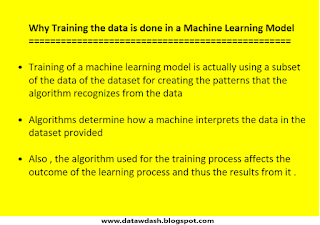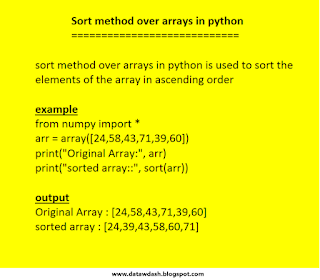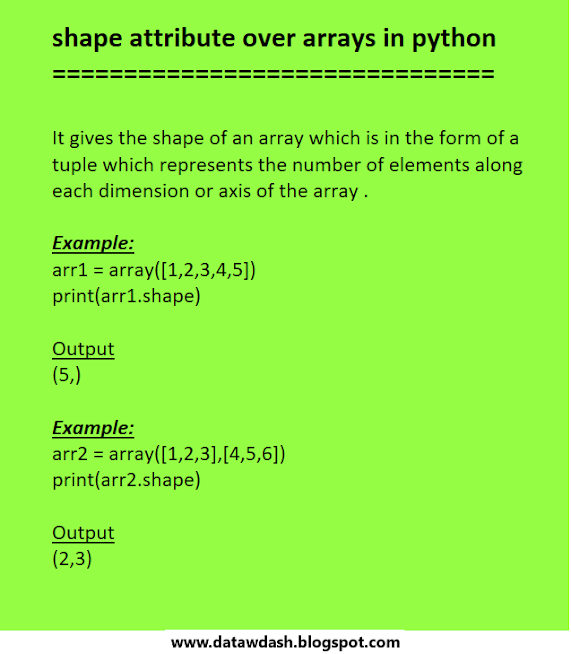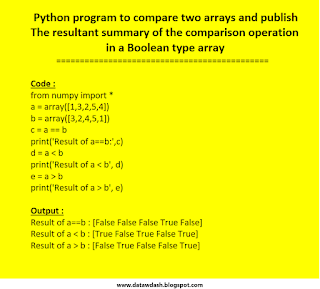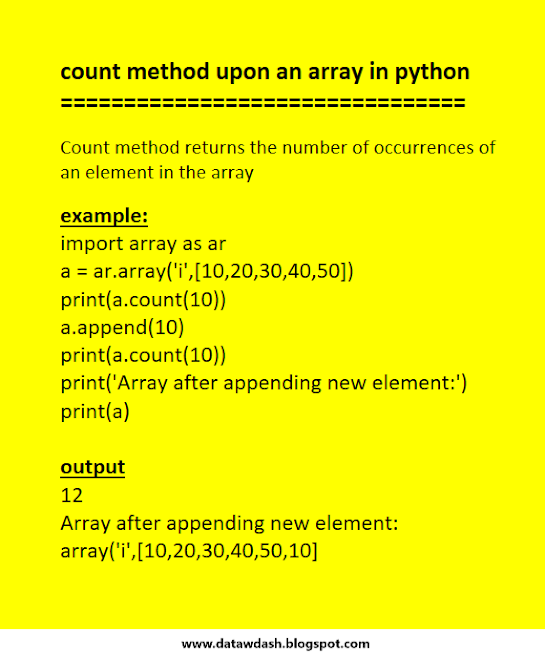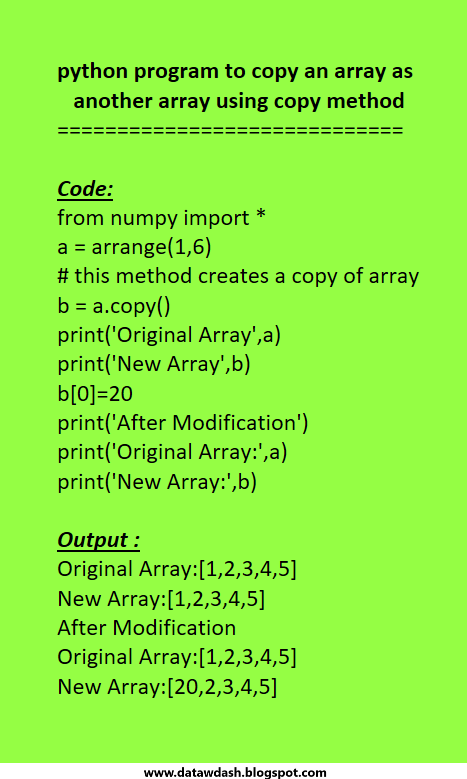Durga Puja in Odisha
Friday, September 18, 2020
Thursday, September 17, 2020
python program to compare two arrays and publish the resultant summary of the comparison operation in a boolean type array
python program to compare two arrays and publish the resultant summary of the comparison operation in a boolean type array
Monday, September 14, 2020
Technology challenges and solutions of big data - Variety
Technology challenges and solutions of big data - Variety
===============================================
Description
To efficiently store large and small data objects and data formats
Solution
Columnar databases using key-pair values format
Technology Used
HBase , Cassandra
what are some technology challenges for big data
what are some technology challenges for big data
what are some technology challenges for big data
- Storing Huge Volumes of Big Data
The very first and foremost challenge over the technology challenges of big data relates to the storing of huge quantities of data . As of now , there is no such computing machine with a storage thatis as big and enough to store the ongoing growing volume of data which has been a big cause of issue for most of the organisations engaged in the business of big data . Therefore , one should first try to store the huge quantity of data in manageable & inexpensive machines and then with upscaling prices and costs one could strive for better infrastructure . However , as it is customary with machines , machines are prone to getting failure at any random point of time and with more and more machines over the big data ecosystem , the chances of failure at any time may also becomes high . Each of the participative and implementable machines in the list could fail at some point or another and failure of a machine could entail a
loss of valuable data stored over them .
- So the first function of big data technology thus should be to store huge volumes of data within them and that too without incurring a high cost to the organization , while also combatting the risk of data loss . So all big data systems distribute data across a large cluster of inexpensive machines connected with each other over the big data network . This process also ensures that all of the data within the system is made failproof by ensuring that every piece of data is stored on multiple machines which would guarantee that at least one copy of the data is available to all the connected storage machines . All the above-mentioned processes are made fail-proof with the help of Hadoop which is a very well-known clustering technology of big data . Hadoop's data storage pattern is called as Hadoop Distributed File System (HDFS). This technology HDFS is built on the pattern's of Google's Big File Systems , which is designed to store billions of pages and sort the pages
to answer user search queries .
Training in Machine Learning
Training in Machine Learning
Training in Machine Learning
========================
- Training provides a learner algorithm with examples
of the desired inputs and also the results expected
from those inputs .The learner algorithm uses these
inputs to create a function
- Training in machine learning context is the process
where a learner algorithm maps a function to the data
and matches up with the inputs to their expected
Outputs
Back-propagation in machine learning
Back-propagation in machine learning
Back-propagation in machine learning
===============================
- Back-propagation or backward propagation of errors
is a method to determine the conditions under which
errors are removed form a neural network which is
built to resemble the human's neurons functions
by changing the weights and biases of the network
continually with a goal to arrive at an actual output
which would match the target output .
- The neurons present in the network catch the transmitted
information and relay the information along to
the next neuron in the line . And in this process , the
entire network is built for relaying the information from
the source of information propagation to the desired
target and in this way each neuron in the network is
shared a portion of the total information relayed and
as such all neurons keep passing information to next
neuron in line until the set of neurons create a final
Output .Thr total sum of errors at the rsult / target ise calculated by the method of Back-propagation
python program to copy an array as another array using copy method
python program to copy an array as another array using copy method
python program to copy an array as
another array using copy method
=============================
Code:
from numpy import *
a = arrange(1,6)
# this method creates a copy of array
b = a.copy()
print('Original Array',a)
print('New Array',b)
b[0]=20
print('After Modification')
print('Original Array:',a)
print('New Array:',b)
Output :
Original Array:[1,2,3,4,5]
New Array:[1,2,3,4,5]
After Modification
Original Array:[1,2,3,4,5]
New Array:[20,2,3,4,5]
Technology Challenges for Big Data
Technology Challenges for Big Data
Question - Technology Challenges for Big Data
--------------------------------------------------------------
Ingesting Streams at an extremely fast pace . This
relates to the velocity of streaming of big data over
the enterprise systems . This velocity of big data
generally relates to the torrential and fast streams of
data . In some cases the velocity of the data streams
may be very large and fast to be stored , but still then
the pace of the data inflow should be monitored
and this can be done by creation of special purpose
ingesting systems that could open multiple number of
channels for receiving , utilisation and consumption
of the data . These ingesting systems could be used
for holding data in queues from which business
applications can read and process data at their own
pace and convenience.
The second layer and second most important purpose
to solve for big data systems is thus managing the
challenge posed by velocity of big data . And to deal
with this issue , special stream-processing engines
have been put in place where all the incoming data is
fed into a central queueing system over the network
of big data machines . From this system , a fork
shaped system sends data to the batch storage as well
as to the stream processing directions . These stream
processing engines can do the work of collection
of high velocity big data and send it to the batch
processing systems who stream the incoming data in
multiple batches and redistribute the volume among
the batch segregation systems . A most popular
system for this type of work handling is apache spark
which handles the work of streaming applications .
Sources of Data over a Big Data Ecosystem
Sources of Data over a Big Data Ecosystem
Sources of Data over a Big Data Ecosystem
===================================
01) Human - Human communications
For example social media like Facebook , Instagram ,
twitter , streaming videos and comments which generate
a lot of one-to-one or one-to-many forms of data
propagation which could be used to store and analyse
sentiments and patterns among the collected data
02) Human - Machine communications
For example web and smart devices over where many people visit and access the required resource for example over an
E-commerce site over where a person / user puts in
requests for products over the page and also accesses
various other products over the displayed section of
any particular attribute or feature or commodity
03) Machine - Machine communications
Communication between the internet of things like mobile to modem communication , mobile to other handheld devices communication connected over internet , health tracking and monitoring fitness bands , seismic activity recorders , weather monitoring and tracking sensors , etc
04) Business transactions
This may include any of the above means and modes of circulation of Information
variety of data - big data
variety of data - big data
Variety of Data
- Big Data is inclusive of the forms of data for all kinds
of functions and from all sources and devices . If
traditional data forms such as invoices and ledgers
were like a small store then Big data can be considered
as the biggest imaginable shopping mall that offers
unlimited variety .
- The three major kinds of variety of data are as follows :
01) FORM OF DATA :
Data types range in variety from numbers to text ,
graph , map , audio , video and many other forms with
some of the data types being simple and the othes
being very complex . There can be composites of
data that include many elements in a single file . For
example , text documents have graphs and pictures
embedded in them . Video movies have audio songs
embedded in them . Audio and Video have different
and vastly much complex storage formats than
numbers and text .Numbers and text can be more
easily analysed than audio or video file
02) FUNCTIONS OF DATA :
There is a lot of data that is being generated form human conversations , songs and movies , business transactions records , machine operations performance data and anew
product design data , old archived data , etc . Human
communication data is needed to be processed very
communication data is needed to be processed very
much differently form operational performance data
with different expectations and objectives . Because
of all these aspects , Big data technologies can be
used to recognise people's faces in ictures , compare
voices to identify speaker of the voice and compare
handwritings to identify the writer also .
03) SOURCE OF DATA :
Mobile phones and tablet devices enable a wide series of applications ( or apps ) to access data and also generate data from anytime and anywhere . Web access and usage and search logs are another new and huge source of data . Businesses and enterprise systems generate massive amounts of structured business transactional information .Temperature and pressure sensors on machines , and Radio Frequency (RFID) tags on assets , generate incessant and repetitive data .
Overall it can summarised as there are three forms of
data and data sources :
(i) human - human communications
(ii) human -machine communications
(iii) machine to machine communications
Defining and Understanding Big Data
Defining and Understanding Big Data
Defining Big Data
===============
* Big Data in quantitative sense implies a huge amount of data with a large database engine with higher complexity and depth
* The sheer amount of data considered as big data is so large
that humans cannot visualize it reasonably without employing machine learning models for any kind of recognition as machine learning enables understanding and use of big data
* A big data source describes a repository that one can get data from and start working over that data to solve general problems with multiple variables and degrees to act upon the data variables
* Big Data involves acquisition of large data and datasets which is a very daunting and challenging job . Also , a big challenge associated with Big Data is the complicated process of storage and transfer of the data for effective processing .
* Another big concern about Big Data is Anonymity as big data presents a lot of concerns about Privacy and Data Protection as well .However , if big data is employed for machine learning problems then privacy and personal data processing might not be such a big issue as the goal of machine learning is to make models for patterns identification and predictions .
How does Machine Learning enable Artificial Intelligence to perform tasks
How does Machine Learning enable Artificial Intelligence to perform tasks
How does Machine Learning enable Artificial
Intelligence to perform tasks
=========================================
1) Machine Learning helps in detection of patterns in
all sorts of data sources
2) Machine Learning helps in creation of new models
based on the recognised patterns and behaviours
3) Machine Learning helps in making decisions
based on the success and failure of the patterns and
Behaviours
Data Handling technique of Machine Learning and Statistics
Data Handling technique of Machine Learning and Statistics
Data Handling technique of Machine Learning and Statistics
=================================================
* Machine Learning works with Big Data in the form of networks and graphs ; raw data from sensors and internet , and the data collected is split into training and test data
* In Statistics , statistical models are created to create the prediction on smaller samples and further analysis for future
data based on earlier past data
What are the distinguishing property of arrays
What are the distinguishing property of arrays
What is the distinguishing property of arrays
====================================
Arrays are a data structure which can increase or
decrease their size in memory at runtime. So , one need
not specify the size of the array at the time of creation
of the array.
What are the types of arrays in data-structure
What are the types of arrays in data-structure
What are the types of arrays in data-structure
======================================
There are two types of arrays :
1) single dimensional arrays or 1D arrays
2) Multi-Dimensional Arrays or 2D arrays
-
what is variance in statistics and how to calculate variance of a small sample - a summary
-
390 - python program to accept two numbers from the keyboard and find their sum python program to accept two numbe...




















